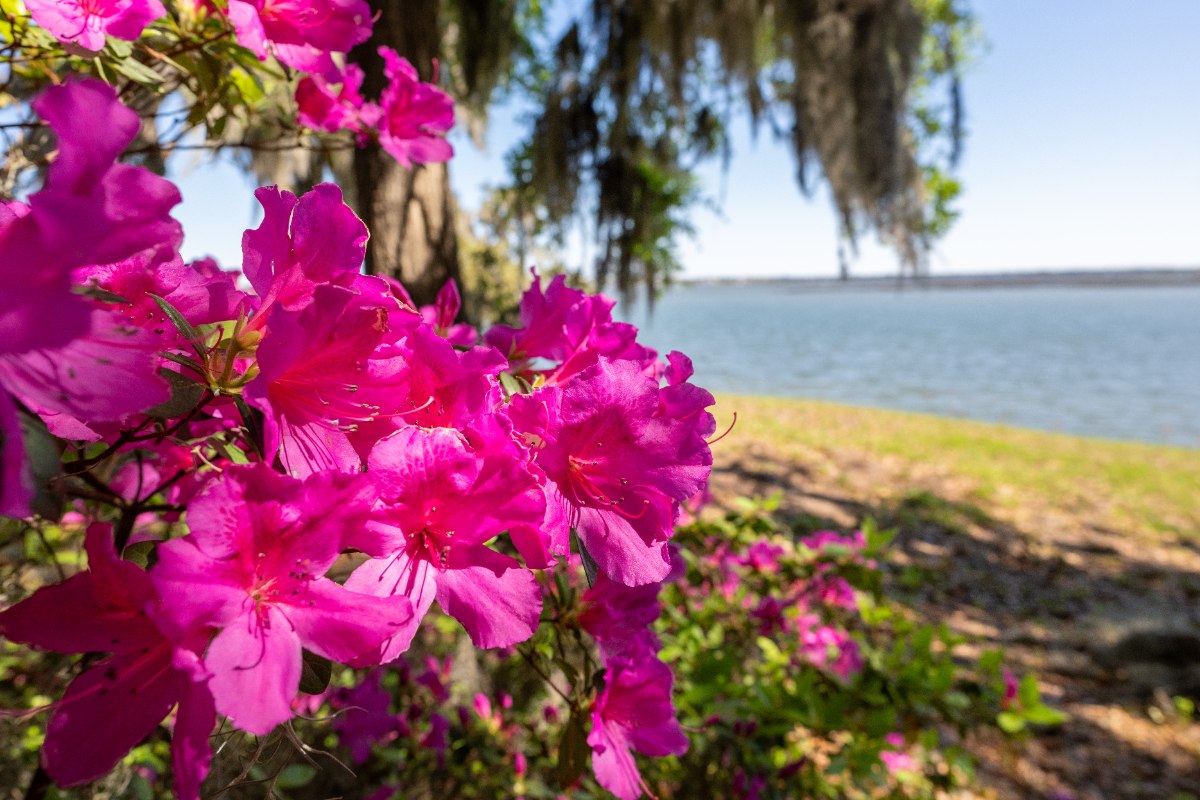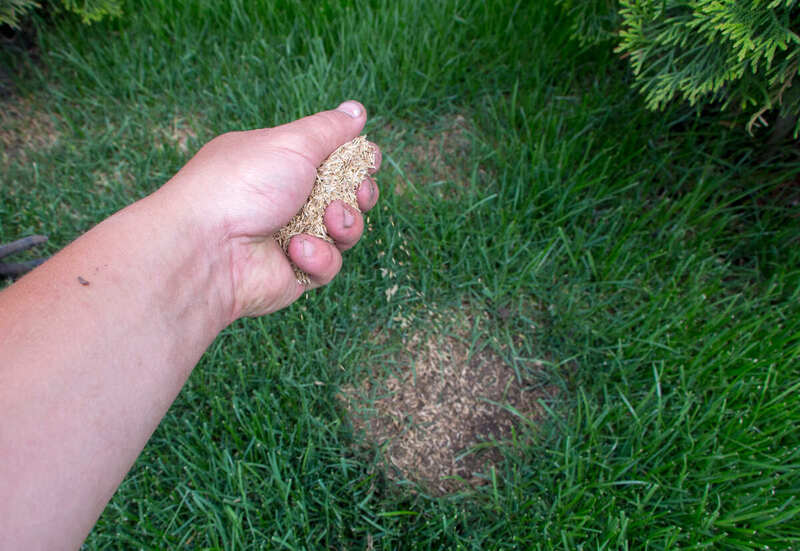
Spring is a critical time for North Florida lawn care. Jacksonville’s warm-season grasses stir to life earlier than in the North, creating unique challenges that require specific approaches like fertilizing in mid-April, mowing at a high setting, and attacking certain weeds and pests that plague Duval County lawns.
Follow these 10 tips tailored to Duval County for a lawn that starts strong and stays vibrant.
Clean Up
Start your spring lawn care by giving the yard a full cleanup. Remove any leaves, pine needles, twigs, and debris that have accumulated on top of the grass over winter. You can do this job by hand, with a rake, or using a leaf blower.
Even though Jacksonville’s winters are short, storms and falling leaves can litter your lawn. Clearing this debris allows sunlight and air to reach your grass, which helps prevent dead spots, mold, and disease while giving your lawn the best chance to green up.
Read more:
Start Mowing at a High Setting
As your lawn begins actively growing again in spring, usually by late March or April in Jacksonville, it’s time to bring out the mower. But resist the temptation to cut the grass short. Set your mower to a high setting for the first mowings of the season.
Cutting grass too short right out of dormancy weakens it. Keeping the grass a bit taller allows it to bounce back faster and stay strong. Follow the one-third rule and don’t forget to check your mower blades are sharp.
Read more: 13 Common Lawn Mowing Mistakes to Avoid
Water Properly
Spring is generally drier than summer in Jacksonville. Lawns need 1 to 1.5 inches of water a week, but Mother Nature generally supplies only about 2 to 2.5 inches per month (roughly half an inch per week on average) in March, April, and May. You’ll need to make up the balance with irrigation.
Unless you get an unusually wet spring, aim to irrigate once or twice a week for a half hour per zone. The best time is early morning, so the water soaks into the lawn before the sun heats up. Avoid evening watering, since grass that stays wet overnight is more likely to develop fungus.
Read more:
Aerate, If Necessary

Spring is a good time to aerate your lawn, but you only need to do it about every other year. Aeration involves punching small holes in the soil to relieve compaction and allow more air, water, and nutrients to reach the roots.
In Jacksonville, heavy foot traffic or clay spots, and even heavy summer rains can pack down the soil. Aerating in spring helps your lawn “breathe” again and take in fertilizer and rainfall more effectively. You can rent a core aerator or hire an aeration service.
Read more:
Dethatch

Thatch is the layer of dead stems and roots between the soil and green blades. A thin layer is normal, but if it’s more than half an inch thick, it blocks water, air, and nutrients from reaching the soil.
In Jacksonville, lawns like St. Augustinegrass and Zoysiagrass can develop thatch over time. Part the grass or cut a small plug to see how thick the layer is. If necessary, rake excess thatch or rent a power dethatcher. Just keep in mind that dethatching stresses the lawn, so only do it when it’s truly needed.
Read more:
Test Your Soil
Before adding fertilizers, test your soil. Jacksonville soils vary; many are sandy and drain quickly, while some are more acidic.
You can use a simple DIY kit or send a sample to the University of Florida Institute of Food and Agricultural Sciences (UF/IFAS). The test will tell you your soil’s pH and nutrient levels. If the pH is too low, you may need lime; if too high, sulfur can help. The test will also reveal if nutrients like phosphorus or potassium are lacking, guiding you to the right fertilizer.
Read more:
Fertilize in Mid-April

Wait until mid-April to fertilize, when your grass is actively growing. If you apply too early, while the grass is still brown or waking up, much of it won’t be absorbed, or it will feed the weeds instead. Use a slow-release fertilizer formulated for your type of grass, and follow the instructions carefully.
The right timing and amount depend on your specific grass variety:
- St. Augustinegrass: Needs moderate feeding. Plan on two applications, one in spring after green-up and another in summer.
- Zoysiagrass: Most home lawns do well with two to three light applications spread between late April and summer.
- Centipedegrass: Low-maintenance. Usually, just one light spring feeding is plenty; too much fertilizer can harm it.
- Bahiagrass: It generally does fine with one feeding in spring and may not need more unless the lawn looks weak.
- Bermudagrass: A fast grower that needs more nutrients than other grasses. Expect to fertilize it several times from spring through summer.
Read more:
Attack Weeds Aggressively

With Jacksonville’s mild winters, spring weeds often show up just as your grass is starting to grow. Act early and use a mix of strategies. Here are the most effective ways to stay ahead of them:
Apply a pre-emergent herbicide in late winter or early spring to block seeds like crabgrass from sprouting. If you missed that window, an early spring application can still help with late-germination weeds. To get rid of existing weeds in small patches, hand-pull them, making sure to get the roots. For widespread growth, use a post-emergent herbicide designed for your turf, and expect to reapply if needed.
Read more:
- How to Prevent Weeds from Growing in Your Lawn
- How to Identify and Control Chickweed in Your Florida Lawn
Pulverize Pests

Spring in Jacksonville doesn’t just wake up your grass; it also wakes up the bugs. Here are the main pests to watch for:
- Chinch bugs: Common in St. Augustinegrass, they create yellow-brown patches in sunny, dry spots.
- Mole crickets: Tunneling pests that damage roots and create spongy, uneven areas.
- Sod webworms and armyworms: These caterpillars chew grass blades and can spread quickly.
- White grubs: Heavy infestations eat roots, leaving grass that wilts and pulls up easily.
- Fire ants: Their mounds can get quite large and unsightly, and their stings are very painful.
Read more:
- How to Get Rid of Chinch Bugs on the Lawn
- How to Get Rid of Mole Crickets in Your Lawn
- How to Get Rid of Sod Webworms
- Lawn Grubs: How and When to Kill Them
- How to Get Rid of Fire Ants
Seed Bare Spots

The best way to fill in bare spots is to throw more seed. Wait for soil temperatures to reach about 70 degrees and be sure to keep the seeds moist until they germinate and take root.
Bonus Tip: Add Mulch
Don’t stop with the lawn; spring is a good time to add or replace mulch in your gardens and landscaping beds. Mulch smothers weeds and insulates soil from the heat of the coming season.
Choose an organic mulch like wood chips. Inorganic mulch can trap heat, which might be good in some regions, but not in sunny Jacksonville.
Read more: Types of Mulch for Your Landscape
Looking for lawn care tips beyond spring? Explore our guides for every season in Jacksonville:
- Summer Lawn Care Tips for Jacksonville
- Fall Lawn Care Tips for Jacksonville
- Winter Lawn Care Tips for Jacksonville
FAQ About Spring Lawn Care
No, we don’t recommend weed and feed. The timing for a weed and feed product is a complete mismatch, as many weed and feed products have a pre-emergent herbicide for their weed control.
No, water deeply and less often, about once a week. Daily watering weakens roots. New grass is the only exception; it needs more frequent watering until established.
The UF/IFAS doesn’t recommend liming your lawn at all unless your soil test says you need it. If you’re not careful, you could kill your lawn if you apply too much lime! Always consult an expert and get a soil test before you lime your North Florida lawn.
Help Your Jacksonville Lawn Spring Back to Life

Spring is a time for growth and recovery. Following these tips can help your Jacksonville lawn bounce back from dormancy and become lush and beautiful again.
If spring lawn care gets too overwhelming, consider hiring a professional lawn care company. Pros can keep your yard in top form while you sit back, relax, and enjoy your green lawn. Contact a Jacksonville lawn care specialist to help with your lawn maintenance today.
Main Image: Azalea flowers bloom during spring in Jacksonville, FL. Photo Credit: Nate.Rosso / Adobe Stock